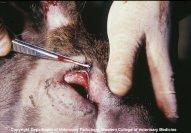| Epizootic
Hemorrhagic Fever |
 |
|
| |
| Causative Agent |
-
Epizootic
Hemorrhagic Disease (EHD) is a viral
disease of wild
ungulates caused by
viruses of the genus Orbivirus.
-
Bluetongue, a viral disease
of wild
ungulates caused by another
Orbivirus, has similar signs and symptoms.
-
The diseases caused by both
Bluetongue and EHD are collectively known as
hemorrhagic disease.
|
| Images |
|
Click on
image to
enlarge. |
 |
|
Hemorrhage in the eyes of a
white-tailed deer infected with EHD. |
|
| Distribution |
|
Geographic: |
-
EHD is widely distributed in both temperate and tropical regions of the
world, but in free-ranging wildlife has only been reported in North America.
-
In BC, it has been reported in bighorn sheep (Ovis
canadensis) and white-tailed deer (Odocoileus
virginianus) in the Okanagan Valley.
|
|
Seasonality: |
-
EHD occurs in late summer and early fall. This is thought to be related
to seasonal wind patterns moving the insect
vector northwards from
endemic areas in the USA.
|
|
| Hosts and Transmission |
| Hosts: |
-
Primarily white-tailed deer and mule deer (Odocoileus hemionus); less frequently elk, pronghorn antelope and
bighorn sheep.
-
Severity of EHD is quite variable and may be related to herd
immunity.
|
|
Transmission: |
-
EHD is transmitted by various species of Culicoides midges (commonly
called no-see-ums).
-
The
virus enters the blood of hosts
from the midge. In some species,
viral replication may occur in
the walls of blood vessels.
-
Blood vessels are damaged
leading to numerous small and large
hemorrhages - hence, the
hemorrhagic nature of this disease.
|
|
| Signs and Symptoms |
-
Signs are variable, ranging from none to sudden death.
-
Sick and dead animals are often found near water.
-
Other signs include:
-
swelling of the face,
tongue, neck and
conjunctiva of the eyes;
-
lack of appetite;
-
weakness and incoordination;
-
excessive salivation, often
blood-tinged;
-
nasal discharge, often
blood-tinged;
-
bloody diarrhea;
-
lameness;
-
extensive
hemorrhaging in many tissues including
the skin,
gastrointestinal tract, heart, testicles;
-
ulcers in the tissues of the
mouth, tongue and stomach;
-
breathing difficulty;
-
recumbancy (lying down);
-
overgrown/cracked hooves.
|
| Meat Edible? |
-
EHD does not infect humans, and eating venison from deer with EHD is not
dangerous; however, secondary infections that may occur as the
disease progresses can render venison unfit for consumption.
-
The meat should not be fed to dogs.
|
| Human Health Concerns and
Risk Reduction |
-
EHD
virus is not associated with
human disease.
|
| Samples for Diagnosis |
-
The whole body should be submitted for post mortem.
-
Immunological tests can verify if EHD
virus is present in the following
tissues, which should be REFRIGERATED
NOT FROZEN:
-
blood collected with
anti-coagulant and the spleen (best);
-
lymph node, lung or bone marrow.
|
| Further Reading |
|
|
|
|

